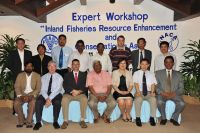Inland Fisheries Resource Enhancement and Conservation in the Republic of Korea
7 February 2010 | Jeung Sook Park | 2329 views | .mp3 | 5.17 MB | Genetics and Biodiversity, Stock enhancement
The beginning of inland fisheries resource stock enhancement in the Republic of Korea dates back to the early 1970’s, when fishing pressure was relatively low, and its development was closely related to the overall trends in the inland fisheries production. The annual average production of inland capture fisheries increased rapidly until the mid 1980’s and was followed by a sharp decline thereafter. Paradoxically, such decrease in commercial capture fisheries brings an opportunity to promote aquaculture development and to reach a social agreement on the needs for intensive enhancement of inland fisheries resources. Consequently, since the 1990’s about 70 percent of the annual inland fisheries production was from aquaculture in comparison to the contribution of nearly 94 percent from capture fisheries until 1980’s. The development of aquaculture-related technology is of use to optimise stock enhancement efforts.
The release of hatchery reared juveniles of inland fisheries resources has become an increasingly common practice for stock enhancement and conservation over the last three decades. The primary purpose of the hatchery practice was to increase the stock size of commercially valuable species in the early stages but now this has changed to compensate for recruitment overfishing and to mitigate disturbances to the environment from human activities. As of 2007, the number of target species for enhancement is eleven, namely common carp, Crucian carp, Korean bullhead, far eastern catfish, Mandarin fish, Japanese eels, sweet fish, aucha perch, mitten crab, melanian snail and soft-shelled turtle. The average number of hatchery-reared juveniles of the eleven target species released is approximately 12 million during the last 5 years, valued at about US$1.3 million. In addition, about 13 million of hatchery-reared salmon were released.
Recently, two more initiatives on stock enhancement and conservation were started to aid depleted inland fisheries populations through the provision of artificial spawning facilities, development of seed production and supply techniques. The former aims to create artificial spawning and rearing environments as hatcheries and the latter to conserve and preserve native species. Regarding native species and ecosystems, the management of invasive alien species is increasingly being addressed. Two introduced species from abroad, largemouth bass and bluegill are listed as invasive alien species that threaten the native ecosystems. On the other hand, protective measures were undertaken such as the establishment of inland water protected areas, closed season for fishing, minimum size limits on fish and shellfish and restrictions on fishing gear.
An impact assessment on inland fisheries resource enhancement and conservation was undertaken in 2007 to deal with melanian snails, Semisulcospira coreana and S. gottschei, the results will be available in early 2010. The hatchery release programme initiated in 1973 is being successfully implemented. Eleven of 16 metropolitan areas and provinces in the Republic of Korea are participating in this programme under the overall guidance of the Ministry of Food, Agriculture, Forestry and Fisheries. Twelve national, provincial and municipal inland fisheries-related institutes play an important role in the implementation of the programme. To improve the current practices and to minimise any possible adverse ecological impacts of stock enhancement, it is recommended to estimate the maximum sustainable biomass, to use genetically sound breeding and seed production, to consider adaptation and mitigation of potential climate change related impacts on inland fisheries and aquaculture and to raise public awareness.
Creative Commons Attribution.
